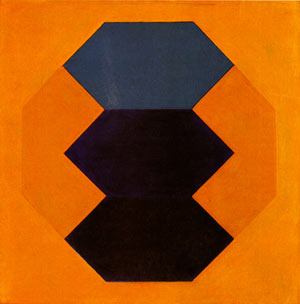work
His richly varied oeuvre began with complex, Tashist paintings, later evolved into nearly monochrome panels, and ended with spacious, geometric compositions. Merwart's friend and companion Peter Baum structures Merwart's work in three distinct periods.Informal Art: Merwart's early iron etchings and his oil paintings from between 1958 and 1960/61 are among the highest quality examples of Austrian Informal Art. This is perhaps the main reason why they were represented at the Kassel documenta in 1959.
Mediative paintings: Around the mid-1960s, color dominated Merwart's works. For the most part painted in landscape format, they concentrate on the subtle escalation of the presence of color, applied in many layers and with extremely delicate overpainting. They radiate calm and equilibrium and are compared with the work of Mark Rothko and Gotthard Graubner.
Mutations – iron etchings and acrylic paintings: From a temporal perspective, this last phase spanned at least one and a half decades. In the second half of the 1960s, the almost complete monochromacity of Merwart's earlier works was loosened up with a stronger gesture and subsequently infused with a geometric, underlying form. Radical reduction to an unprecedented degree, along with a commitment to form, became increasingly prominent in the artist's work. Similarly powerful as his approach to color, his experimentation with plate elements produced iron etchings that are unequalled in their precision. In painting, Merwart turned away from oil colors for technical reasons and used acrylics instead.
See: Peter Baum, Ludwig Merwart, "Gemälde und Eisenätzungen" 1958 – 1978, Landesmuseum Lower Austria – Kulturabteilung der NÖ Landesregierung, Neue Galerie der Stadt Linz, 1982.

